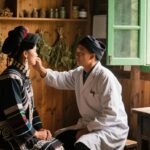Shanzao Gui (Liver Cancer)
Overview
Miao medicine calls liver cancer Shanzao Gui, a disorder of the liver framework region. This disease often evolves from poorly‑resolved jaundice (Xiutiaofang), cirrhosis (Mengshan Dawa), or other chronic liver disorders, and belongs to the category of malignant toxic syndromes. Its causes include congenital constitutional abnormalities, emotional imbalance, dietary injury, invasion of pathogenic toxins, or the long‑standing mix of diseases like jaundice and cirrhosis that damage the zang‑fu and disrupt their harmony, thereby causing malignant transformation in the liver framework.
Traditional Chinese Medicine classifies liver cancer under the “accumulation” category, referring to internal masses formed by qi stagnation, blood stasis, and phlegm turbidity, which present as palpable abdominal or hepatic nodules with associated distension or pain.
Western medicine defines liver cancer as a multi‑factorial malignant tumor, divided into primary and secondary types. Secondary liver cancer arises when tumors from other organs metastasize to the liver; primary liver cancer originates in hepatic epithelial or mesenchymal tissue, often evolving from hepatitis B infection or cirrhosis. Clinically, it may present with liver‑region pain, poor appetite, nausea, and vomiting.
Huhou Jipeng · Miao Medicine Presentation
Shanzao Gui is considered a malignant toxic syndrome and is subdivided into two patterns:
Xiaoguo Gui (Benign Tumor)
Ezao (Malignant Cancer)
Aijiangduo · Etiology
Miao medicine holds that Shanzao Gui is caused by emotional imbalance, dietary injury, invasion of pathogenic toxins, and congenital constitutional defects; or by long‑standing, improperly treated diseases such as jaundice (Xiutiaofang) and cirrhosis (Mengshan Dawa). These factors jointly damage the liver framework qi, triggering malignant mutations and the development of cancerous syndromes.
Gengduomeng · Pathogenesis
This disease onset is slow. Early symptoms are not obvious because damp‑heat, phlegm turbidity, food stagnation, and blood stasis accumulate internally over time. Multiple interacting causes disrupt the generation and flow of qi and blood and impair fluid metabolism. Ultimately, the righteous qi is depleted, qi stagnates and blood stasis forms, leading to malignant transformation.

Diagnostic Essentials
Diagnostic Criteria
(1) Palpable masses of varying size in the liver framework region, fixed and non‑mobile, often tender with a defined location, developing slowly and chronically.
(2) History of emotional upset, dietary irregularity, invasion of external pathogens, or long‑term jaundice, hypochondriac pain, malaria, or other chronic diseases.
(3) Exclusion of other “accumulation” syndromes in internal medicine.
Supporting Examinations
CBC, urinalysis, stool analysis
Liver biochemistry, serum tumor markers for liver cancer
Ultrasound, CT, digital subtraction angiography (DSA), MRI
Liver biopsy and immunologic assays
Differential Diagnosis
Mengshan Dawa (Cirrhosis)
Both Shanzao Gui and cirrhosis involve liver‑framework disease from emotional strain or parasitic toxins. Cirrhosis arises from emotional upset, alcoholism, or schistosomiasis, leading to liver framework qi‑blood storage failure, with tenderness, palpable nodules, acid regurgitation, poor appetite, and abdominal distension. Shanzao Gui arises from emotional imbalance, dietary injury, toxin invasion, or chronic mis‑/untreated jaundice and cirrhosis, leading to malignant transformation in the liver framework. Its hallmark is chronic, fixed, tender liver masses of varying size.
Syndrome Differentiation & Treatment
1. Xiaoguo Gui (Benign Tumor)
Presentation (Mengli Duo):
Early stage is often asymptomatic or non‑specific: mild rib‑side fullness, poor appetite, and weight loss.
Pattern (Xing Leng):
Cold‑type syndrome in the cold channel.
Principle (Jia He Meng):
Detoxify and disperse tumor (guandu xiuzeng), move qi and resolve stasis (hang qi huayu).
Prescription (Ou Duo Xi Jia, Gang Ou):
Houttuynia cordata (Houttuynia cordata, yuxingcao) 50g
Sophora tonkinensis (Sophora tonkinensis, shandougen) 10g
Aster tataricus (Aster tataricus, ziwan) 10g
Panax ginseng (Panax ginseng, renshen) 10g
Solanum nigrum (Solanum nigrum, longkui) 20g
“Cat’s ear grass” (Cat ear herb, baiying) 20g
Epimedium sagittatum (Epimedium sagittatum, yanghuo) 20g
Eleutherococcus senticosus (Eleutherococcus senticosus, ciwujia) 20g

Decoction for oral administration.
2. Ezao (Malignant Cancer)
Presentation (Mengli Duo):
Pain in the liver area, abdominal distension, poor appetite, fatigue, weight loss, palpable masses of varying size; some patients have low‑grade fever, jaundice, diarrhea, or upper GI bleeding.
Pattern (Xing Leng):
Heat‑type syndrome in the heat channel.
Principle (Jia He Meng):
Attack and eliminate toxins (gongdoui), move qi to relieve pain (hang qi zhentong).
Prescription (Ou Duo Xi Jia, Gang Ou):
Paris polyphylla (Paris polyphylla, qiyeyizhihua) 15g
Taraxacum mongolicum (Taraxacum mongolicum, pugongying) 15g
Trichosanthes kirilowii root (Trichosanthes kirilowii, gualougen) 15g
Prunella vulgaris (Prunella vulgaris, xiakucao) 15g
Hedyotis diffusa (Hedyotis diffusa, baihuasheshecao) 15g
Clematis chinensis (Clematis chinensis, weilingxian) 15g
“Soap pod thorn” (Soap pod thorn, zaoyingci) 6g
Human placenta powder (Placenta hominis, zihechefen) 6g (added after decoction)
First decoct the first seven herbs; then stir in placenta powder orally.
Preventive Care
Eliminate or avoid the causes of liver cancer as the fundamental preventive measure.
Keep emotions smooth and qi‑blood circulating.
Regulate diet; avoid smoking and alcohol.
Maintain moderate work and rest, with regular daily routines.
Notes
Liver cancer is a malignant tumor of the liver, including primary and secondary types. Primary liver cancer is the most common clinical malignancy. Early disease may be asymptomatic; mid‑to‑late stages exhibit liver‑region pain, distension, poor appetite, fatigue, weight loss, progressive hepatomegaly or upper abdominal masses, and some patients have low fever, jaundice, diarrhea, or GI bleeding. Prevention and (used in traditional contexts) emphasize screening high‑risk groups for early detection, diagnosis, and (used in traditional contexts) to improve outcomes. Miao medicine holds that no illness arises without toxins; cancer results from the interweaving of internal and external toxins that disrupt normal physiology, causing chaos in the body’s material, energy, and structure. Treatment requires a comprehensive approach: attack and eliminate toxins while nourishing and restoring the body’s righteous qi.


Leave a Reply